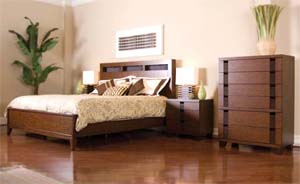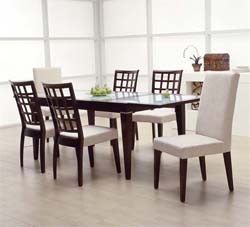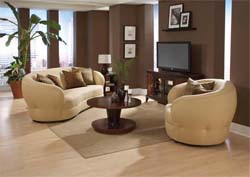 Okay, "green" is the talk of the town, from apparel to cereal to headphones to shampoo. People want healthy alternatives, but they just haven't thought about it with furniture. The good news is there are lots of innovative ways to be conscious of your environmental impact on the earth without sacrificing an ounce of beauty.
Okay, "green" is the talk of the town, from apparel to cereal to headphones to shampoo. People want healthy alternatives, but they just haven't thought about it with furniture. The good news is there are lots of innovative ways to be conscious of your environmental impact on the earth without sacrificing an ounce of beauty.
When it comes to decorating, it's not just a matter of style, color and design anymore. We need to be alert to what goes into furniture and how to find safe and functional alternatives.
Let's discuss a few basics. One of the most common words used in the conversation and explanation of eco-friendly programs is the word "sustainable". Sustainable development is "development that meets the needs of the present generation without compromising the ability of future generations to meet their own needs".
Many home furnishings companies are now strong supporters of "sustainability" issues. In fact, The Sustainable Furniture Council was formed to support eco-friendly home furnishings. The Council is a non-profit balanced coalition of industry players created to promote sustainable practices among manufacturers, retailers, and consumers alike with a public tagging program to identify good choices.
 Sustainability of our forests is obviously a frequent topic in the context of the environment. Sustainable forestry consists of management practices that ensure the health and growth of our forests for future generations. As the population expands and the economy grows, responsible people are concerned about our forests, and they want assurances that our forests will always be there. In the context of furniture, non-toxic and natural American hardwoods are among the most sustainable materials on earth. Unlike composites or synthetics, solid wood responsibly grown and managed offers generations of beauty and comfort.
Sustainability of our forests is obviously a frequent topic in the context of the environment. Sustainable forestry consists of management practices that ensure the health and growth of our forests for future generations. As the population expands and the economy grows, responsible people are concerned about our forests, and they want assurances that our forests will always be there. In the context of furniture, non-toxic and natural American hardwoods are among the most sustainable materials on earth. Unlike composites or synthetics, solid wood responsibly grown and managed offers generations of beauty and comfort.
Sustainability of our forests is obviously a frequent topic in the context of the environment. Sustainable forestry consists of management practices that ensure the health and growth of our forests for future generations. As the population expands and the economy grows, responsible people are concerned about our forests, and they want assurances that our forests will always be there. In the context of furniture, non-toxic and natural American hardwoods are among the most sustainable materials on earth. Unlike composites or synthetics, solid wood responsibly grown and managed offers generations of beauty and comfort.
Here's a shortlist of ways to make your home greener.
 When it comes to upholstery, you don't have to settle for plain brown burlap fabric to be environmentally friendly. Organic cottons, hemp, recycled materials and fabrics that haven't been bleached, treated with harsh shampoos, or colored with synthetic dyes are among the many fashionable options now available. Many collections feature nature-inspired fabric designs, available in dozens of rich colors that are certified organic and contain no carcinogens or toxins. Those wool materials are supplied from free-range farms and the ramie fiber is organic. Hemp is a durable, natural fabric that doesn't rely on pesticides and isn't bleached. Many hemp blends and fabrics are suitable for window treatments and upholstery. The hemp fabrics dye more readily than cotton or linen, and thus eliminate the need for a chemical-laden pre-wash. While seeking the most in environmental furniture, don't overlook construction materials. Glues, finishes, stains and waxes can also be a source of unwanted chemicals.
When it comes to upholstery, you don't have to settle for plain brown burlap fabric to be environmentally friendly. Organic cottons, hemp, recycled materials and fabrics that haven't been bleached, treated with harsh shampoos, or colored with synthetic dyes are among the many fashionable options now available. Many collections feature nature-inspired fabric designs, available in dozens of rich colors that are certified organic and contain no carcinogens or toxins. Those wool materials are supplied from free-range farms and the ramie fiber is organic. Hemp is a durable, natural fabric that doesn't rely on pesticides and isn't bleached. Many hemp blends and fabrics are suitable for window treatments and upholstery. The hemp fabrics dye more readily than cotton or linen, and thus eliminate the need for a chemical-laden pre-wash. While seeking the most in environmental furniture, don't overlook construction materials. Glues, finishes, stains and waxes can also be a source of unwanted chemicals.